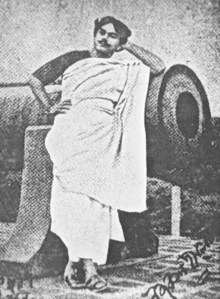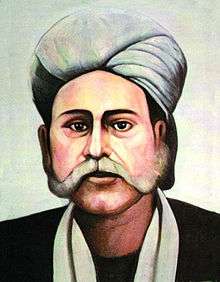Music of Bangladesh
| Music of Bangladesh | |
|---|---|
 | |
| Genres | |
| Specific forms | |
| Religious music | |
| Ethnic music | |
| Traditional music | |
| Media and performance | |
| Music awards | |
| Music festivals | |
| Music media |
Radio Television Internet |
| Nationalistic and patriotic songs | |
| National anthem | Amar Sonar Bangla |
| Other |
Notuner Gaan (National March) Ekusher Gaan (Ode to the Language Movement) |
| Regional music | |
| Related areas | |
| Other regions | |
| Part of a series on the |
| Culture of Bangladesh |
|---|
|
Rice Bread Fish Sweets Snacks Sauce |
| Religion |
|
Architects Painters Sculptor |
|
Literature History Genres Institutions Awards Writers |
|
Music and performing arts |
|
Monuments |
|
The music of Bangladesh, also referred to as Bangladeshi music, comprises a long tradition of religious and secular song-writing over a period of almost a millennium. Composed with lyrics in the Bengali language, Bengali music spans a wide variety of styles. In Bangladesh music has served the purpose of documenting the lives of the people and was widely patronized by the rulers.
Classical

Bangladeshi classical music is based on modes called ragas (rag, in Bengali). All traditional Bengali music tend to be based on various variations of Hindustani Classical Music.
Folk

Folk has come to occupy the lives of Bangladeshis almost more than any other genre of Bengali music. Among the luminaries of the different folk traditions are Lalon Fokir, Radharaman Dutta, Hason Raja, Khursheed Nurali (Sheerazi), Ramesh Shill and Abbas Uddin. Folk songs are characterised by simple musical structure and words. Before the advent of radio, entertainment in the rural areas relied on a large extent on stage performances by folk singers. With the arrival of new communication technologies and digital media, many folk songs were modernised and incorporated into modern songs (Adhunik songeet).
Folk music can be classified into several subgenres:
- Baul: mainly inspired by Lalon Fokir and almost exclusively performed by hermits.
- Bhandari: devotional music from the South (mainly Chittagong).
- Bhatiali: music of fishermen and boatman, almost always tied by a common raga (mode), sung solo.
- Bhawaiya: song of bullock-cart drivers of the North (Rangpur).
- Dhamail: a form of folk music and dance originated in Sylhet, Bangladesh. It is practiced in the erstwhile district of Sylhet in Bangladesh and in areas influenced by the Sylheti culture such as Cachar, parts of Shillong, Karimganj and Hailakandi Districts of Assam, parts of Tripura in India.
- Ghazal: Popularity of folk music of Sufi genres: introduction of philosophy and religion in music.
- Gombhira: song (originating in Chapai Nawabganj, in the Northwest) performed with a particular distinctive rhythm and dance with two performers, always personifying a man and his grand father, discussing a topic to raise social awareness.
- Hason Raja: devotional songs written by a music composer by the name of Hason Raja (from Sylhet, northeastern side of Bangladesh near Assam) that was recently repopularised as dance music.
- Jari: songs involving musical battle between two groups
- Jatra Pala: songs associated exclusively with plays (performed on-stage). Usually involves colourful presentations of historical themes.
- Kirtan: devotional song depicting love to Hindu God Krishna and his (best-known) wife, Radha.
- Kavigan: poems sung with simple music usually presented on stage as a musical battle between poets.
- Lalon: best known of all folk songs and the most important subgenre of Baul songs, almost entirely attributed to spiritual writer and composer, Lalon Fokir of Kushtia. He is known to all in West Bengal of India too.(Western Bangladesh, near the border with West Bengal).
- Sari: sung especially by boatmen. It is often known as workmen's song as well.
- Shyama Sangeet: a genre of Bengali devotional songs dedicated to the Hindu goddess Shyama or Kali which is a form of supreme universal mother-goddess Durga or parvati. It is also known as Shaktagiti or Durgastuti.[1]
Baul
Baul is the most commonly known category of Bangladeshi folk songs. It is mostly performed by hermits who are followers of Sufism in Bangladesh. Present day Sufis earn mainly from performing their music. Baul songs incorporate simple words expressing songs with deeper meanings involving creation, society, lifestyle and human emotions. The songs are performed with very little musical support to the main carrier, the vocal.
Instruments used include the Ektara ("one-string"), Dotara ("two-strings"), ba(n)shi (country flute made from bamboo) and cymbals. In recent times, Baul geeti has lost popularity, due to urbanisation and westernisation.
Adhunik
Adhunik sangeet literally means "modern songs". Although, to outsiders, this may seem like an ambiguous nomenclature, it has particular motivations.
Bengali music traditionally has been classified mainly by the region of origin and the creators of the musical genre, such as Nazrul geeti (written and composed by Kazi Nazrul Islam), ghombhira (unique to a specific area in Bangladesh), etc. However, this prevented the ability to classify any music that failed to fit into any of the classes. In the period just before Indian independence, several new minor musical genres emerged, mainly in the form of playback songs for movies. A miscellaneous category, Adhunik sangeet, was created, since, at that time, this music was "modern".
Rabindra Sangeet
Rabindra Sangeet (Bengali: রবীন্দ্রসঙ্গীত Robindro shonggit, Bengali pronunciation: [ɾobind̪ɾo ʃoŋɡit̪]), also known as Tagore Songs, are songs written and composed by Rabindranath Tagore. They have distinctive characteristics in the music of Bengal, popular in India and Bangladesh.[2] "Sangeet" means music, "Rabindra Sangeet" means Songs of Rabindra.
Rabindra Sangeet used Indian classical music and traditional folk music as sources.[3]
Nazrul Geeti
Nazrul Geeti or Nazrul Sangeet, literally "music of Nazrul," are songs written and composed by Kazi Nazrul Islam, a Bengali poet and national poet of Bangladesh and active revolutionary during the Indian Independence Movement. Nazrul Sangeet incorporate revolutionary notions as well as more spiritual, philosophical and romantic themes.
Modern music and western influence
Modernisation of Bengali music occurred at different times and, for the most part, independent of western influence. Most notable of these changes were:
Film music
The film industry of Bangladesh supported music by according reverence to classical music while utilizing the western orchestration to support melodies.
Rock music
Bangladeshi rock was introduced in 1972 by singer, songwriter, music composer Nasir Ahmed Apu of Spondan band, pioneer of Bengali pop/rock and re-invented Bengali folk music in Bangladesh. Spondan was founded in Dhaka, Bangladesh on 17 January 1972. Spondan's " Emom Ekta Ma Deana ' , " Sritiro Shai pote ajo " songs written, tune and music by Nasir Ahmed Apu, Vocal by Ferdous Wahid,Record label Bangladesh Gramophone company, 1975 are all time hit. Other popular songs created by Nasir Ahmed Apu of Spondan are "Paglar mon Nacchaya ", (Vocal by Ferdous Wahid, record label- Dhaka Record, 1974) " Ai Montare Daana mele diechi vocal by Nasir Ahmed Apu recorded in 1974 ), Shajiey gujie de more ( recorded in 1976 )and further more. Uccharon was formed in 1973 and their first released album was " Ore Saleka, and High court er Majhare " vocal by Azam Khan of Uccharon, record label Dhaka Record, 1973. Subsequently other contributory bands areSouls, Miles, Nagar Baul, Warfaze, RockStrata, LRB and Ark.
| Formed | Name | Genre | Language | City of origin |
|---|---|---|---|---|
| 1970 | Souls | pop/rock | Bengali | Chittagang |
| 1970 | Uccharon | Pop rock | Bangla | Dhaka |
| 1972 | Spondan | pop/rock | Bengali | Dhaka |
| 1976 | Feedback | Rock music | Bangla | Dhaka |
| 1978 | Miles | Pop rock | Bangla | Dhaka |
| 1980 | Nagar Baul | Hard rock, psychedelic rock | Bangla | Chittagong |
| 1980s | Different Touch | Pop rock | Bangla | Khulna |
| 1984 | Warfaze | Hard rock, heavy metal music | Bangla | Chittagong |
| 1985 | Rockstrata | Heavy Metal | Bangla | Dhaka |
| 1986 | Nova | Rock music, Hard rock, Psychedelic rock | Bangla | Dhaka |
| 1991 | Love Runs Blind | Alternative rock | Bangla | Chittagong |
| 1991 | Ark | Pop rock | Bangla | Chittagong |
| 1993 | Cryptic Fate | Progressive metal | Bangla | Dhaka |
| 1996 | Shironamhin | Folk music, alternative rock, psychedelic rock | Bangla | Dhaka |
| 1996 | Dalchhut | Rock music | Bangla | Dhaka |
| 1998 | Aurthohin | Rock music, Heavy Metal | Bangla | Dhaka |
| 1998 | Black | Rock music, alternative rock, grunge | Bangla | Dhaka |
| 1998 | Poizon Green | Thrash/Power Metal | English | Dhaka |
| 1999 | Artcell | Progressive metal, progressive rock | Bangla | Dhaka |
| 1999 | Scarecrow | Thrash Metal, metal core | Bangla | Dhaka |
| 1999 | Nemesis | Alternative rock | Bangla | Dhaka |
| 2000 | Lalon | Rock | Bangla | Dhaka |
| 2001 | Stentorian | Hard rock, heavy metal | Bangla | Dhaka |
| 2001 | Vibe | Heavy Metal | Bangla | Dhaka |
| 2001 | Satanik | Black Metal | English | Dhaka |
| 2002 | Arbovirus | Experimental music, alternative rock, Nu metal | Bangla | Dhaka |
| 2004 | Severe Dementia | Death Metal | English | Dhaka |
| 2004 | Funeral Anthem | Power Metal | Bangla | Dhaka |
| 2005 | Shohortoli | Theatrical rock | Bangla | Dhaka |
| 2006 | De-illumination | Symphonic rock, symphonic metal | Bangla | Dhaka |
| 2006 | Mechanix | Heavy Metal | Bangla | Dhaka |
| 2006 | Powersurge | Thrash Metal | Bangla | Dhaka |
| 2007 | Shunno | Pop rock | Bangla | Dhaka |
| 2007 | Bishorgo | Rock | Bangla | Chittagong |
Fusion
Fusion, traditional music with Western instrumentation to revitalize and re-popularize Bengali music. Joler Gaan and Lampost are one of the best popular Fusion bands in Bangladesh.
Hip Hop
Stoic bliss and deshi mc's are two of the notable hip hop artists of Bangladesh
Contemporary Urban Bangla Music
A new growing genre of Bangladesh music is contemporary urban music.Contemporary Urban music got popularity with the introduction of American and British television channels and Hollywood movies.Recently, A Canadian Bangladeshi singer, Master D started singing urban music generes like RnB, Soul, Grime, Hip Hop. Thus urban music started getting popularity in Bangladesh. Master D's first single "Aye Raat" , released in October 2014 and created a new sensation in The Bangladeshi modern music scene. Master D's other notable singles include 'tumi chole gele', 'tension stress'( ft. Bohemia), 'Desi Chick', 'Count on me'.
Notable bangla urban artists include Master D, Shahriar, Stoic Bliss, and Rajib.
Instruments
Common instruments are:
- Sitar
- Violin
- Flutes
- Harmonium
- Esraj (a traditional Bengali instrument)
- Ektara ("one-string")
- Dotara ("two-strings")
- Khomok
- Dhak
- Dhol
See also
- Bengali folk literature
- Culture of Bengal
- Culture of India
- Culture of West Bengal
- History of Bengali literature
- Music of Bengal
- Music of West Bengal
References
- ↑ Sayeed, Khan Md (2012). "Shyamasangit". In Islam, Sirajul; Jamal, Ahmed A. Banglapedia: National Encyclopedia of Bangladesh (Second ed.). Asiatic Society of Bangladesh.
- ↑ Ghosh, p. xiii
- ↑ Huke, Robert E. (2009). "West Bengal". Encyclopædia Britannica. Encyclopædia Britannica Online. Retrieved 2009-10-06.